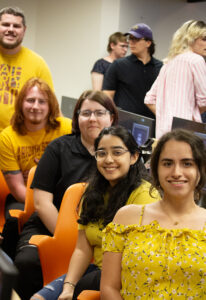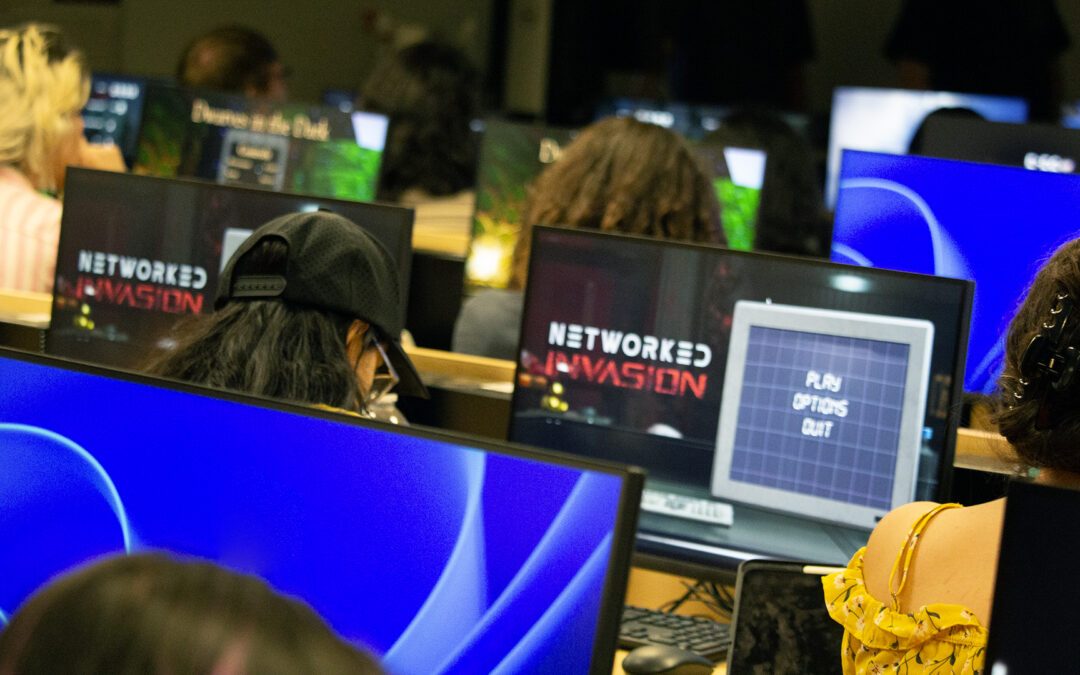Attention humans: AI has taken over the H.I.V.E. Well, in the game world created by a team of game design students, it has anyway.
Out here in the real world, we’re quite safe, but PC gamers who enter the world of NETWORKED INVASION will find themselves completing intense puzzles and fighting for survival in Colony Typhus.
The project was one of a variety of innovative games demonstrated at the Game Design Capstone Showcase on Wednesday, April 24 in the School of Computing and Augmented Intelligence, or SCAI, part of the Ira A. Fulton Schools of Engineering at Arizona State University. Student teams, made up of graduating and rising seniors, presented projects they completed over two semesters as part of their participation in the cross-disciplinary computer gaming certificate program.
The program, overseen by Yoshihiro Kobayashi, an associate teaching professor in SCAI, recently made the Princeton Review List of Top 50 Undergraduate Schools for Game Design for 2024. The program is designed to provide a game development skill set that the student can apply to domain-specific project in their major.
NETWORKED INVASION was one such project. Six students worked collaboratively to create demo levels using the Unreal Engine 5.3. To create the futuristic, dystopian visuals, the students used Blender, Adobe Substance Painter and 3Ds Max. They even created their own soundtrack using BandLab.
Leticia de Aveiro Ramos, who served as art lead on the project, said that the game’s design inspiration came from the team’s mutual love of horror and science fiction films. They imagined a future where space exploration had been farmed out to for-profit corporations, who in turn, had created an artificial intelligence, or AI, system to manage critical tasks on a space station to cut costs. The result is that a team of players will find themselves trapped in an environment full of rogue drones, malfunctioning equipment and hostile aliens infiltrating the dilapidated space station.
“We really want players to feel a sense of fear as they are exploring the world,” says Ramos. “We wanted them to feel the pressure of having to complete puzzles to keep themselves alive.”
Shelbie Pyeatt, the team’s UI programmer, says the team hopes to keep going and generate more content for playable levels.
Students who want to work in the electronic gaming industry or are interested in learning more about game design and the technology behind them should check out the computer gaming certificate program.
“We highly recommend ASU as well as the other outstanding schools on our 2024 lists to students considering a career in the exciting field of game design,” said Rob Franek, The Princeton Review’s Editor-in-Chief. “Their faculties are superb. Their facilities are state-of-the-art, and their alumni include many of the industry’s most successful game designers, developers, and entrepreneurs.”

Congrats to the NETWORKED INVASION team:
Aparajita Limaye: Enemy and puzzle programmer
Connor Gurley: Narrative Designer
Katherine Akers: Level designer and music producer
Leticia de Aveiro Ramos: Art lead and assistant level designer
Nicholas Hildebrant: Engine and gameplay programmer
Shelbie Pyeatt: UI programmer
